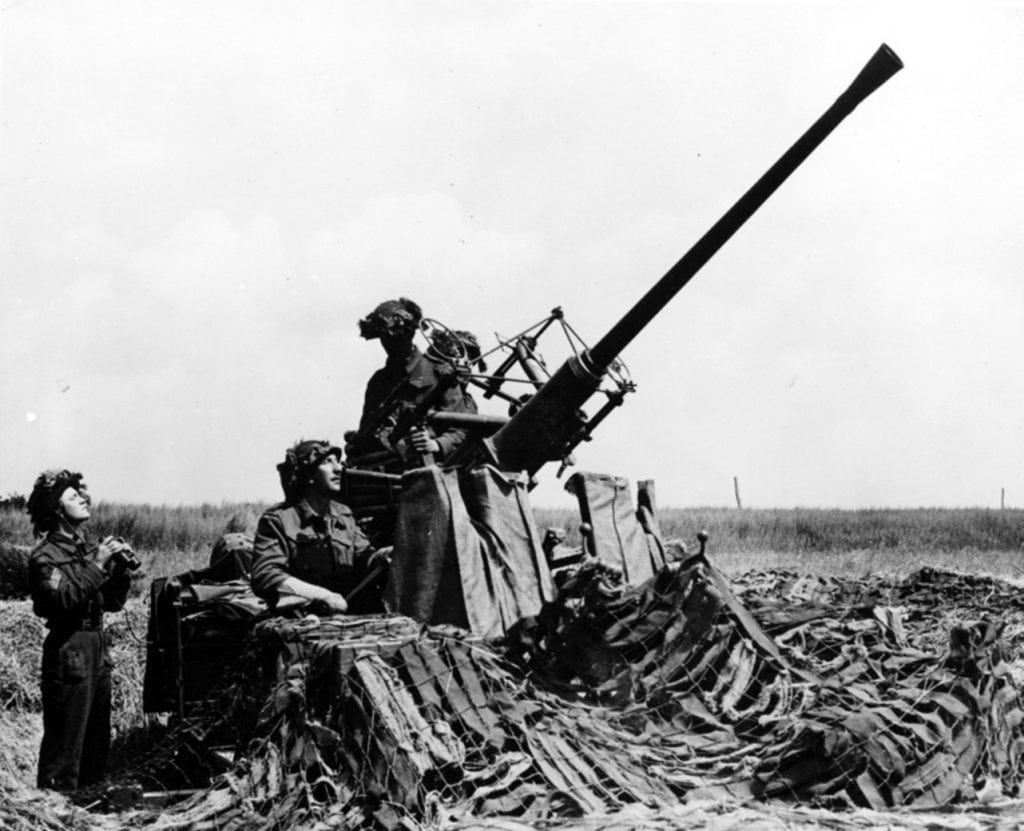Bofors 40mm Light Anti-Aircraft Gun
In 1941, Canada acquired the Swedish-designed 40mm Bofors Light Anti-Aircraft (Bofors gun) to replace obsolete WW1 artillery. Deployed for light anti-aircraft defence and as a multipurpose gun against land targets, the Bofors gun earned a reputation for accuracy and reliability. Allies and Axis powers purchased and built versions of the Bofors gun, which saw action in all theatres of war during WW2. Allied war production included over 19,000 units.
The Bofors gun was an autocannon, with a standard rate of fire of 120 rounds per minute, firing a 1.6-inch (40 mm) calibre, 900-gram (2-pound) HE high explosive round. The round included a proximity fuse, designed to detonate when near a target, increasing the probability of hitting low-flying enemy aircraft. The maximum firing ceiling was 23,600 feet (7,200 metres), with an effective range of 12,500 feet (3,800 metres). The Bofors could elevate and fire past 90 degrees and at a low angle of -5 degrees.
My grandfather, Charles Oakden, served with the 4th Light Anti-Aircraft (LAA) Regiment during WW2. The Canadian Army had seven LAA Regiments in Europe, each with 24 Bofors guns and approximately one thousand personnel. Canada raised the 4th LAA Regiment in February 1941, arriving in Essex, England, in September 1941, then receiving 40mm Bofors guns. The 4th LAA Regiment served in a Defence of Britain role from 1941-44 and were known for shooting down 61 enemy planes over a two-month timeframe, a record number for the war. Their motto was “Bring on the Luftwaffe.”

LAA in France with Bofors gun, 1944.
For the Allies, the Bofors 40mm gun provided a vital light anti-aircraft function during the Battle of Britain (September 1940 to May 1941) and played a significant anti-aircraft role in defending Britain until the end of WW2. From 1941 to 1945, 40mm Bofors represented more than half of the anti-aircraft guns in Canada for air defence. In the First Canadian Army, two-thirds of the light anti-aircraft guns were 40mm Bofors, self-propelled and towed versions, with the remaining third, 20mm Polsten machine guns mounted on quad trucks.
On D-Day, June 6, 1944, one battery from the 4th LAA Regiment landed on Juno Beach at H plus 7 hours, with most of the regiment arriving on June 12, 1944. The 4th LAA Regiment fought across Northwest Europe, fighting in France from June to September 1944, Belgium from October to November 1944, Holland from November 1944 to February 1945, and Northern Germany from February to VE Day. In addition to their anti-aircraft role, they also served in infantry roles, defending their guns. In October 1944, at the Battle of the Scheldt, they turned their 40mm guns down at buildings and enemy strongpoints, pulverizing targets with 2-pound HE rounds at 120 rounds per minute.
Canadian LAA units helped secure the skies during the Normandy landing. Its direct-fire cartwheel sight and No. 3 Predicter automated sighting system allowed troops to engage enemy aircraft quickly and effectively. After the Normandy Landing, LAA units, such as the 4 LAA, continued to target the Luftwaffe. In 1944-45, across Northwestern Europe, Canadians deployed the Bofors against the low-flying German aircraft and in multipurpose roles against ground targets.
Post-WW2, the Bofors gun had a lasting impact on military doctrine and 20th-century weapon development. Its usage worldwide demonstrated a future need for reliable anti-aircraft defences, leading to more advanced air defence systems. Armies worldwide deployed the Bofors gun in the following notable conflicts: WW2, the Korean War, the Vietnam War, the Falklands War, the Gulf War, and the Yugoslav Wars. In Canada, the Bofors gun remained in service until 1959. A variant of the gun, a Boffin 40mm, returned to service to defend Canadian airfields in Germany from 1970 to 1989.
By Andrew Oakden
